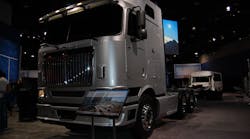The short-term pain facing Navistar in the wake of its decision to embrace In-cylinder Technology +, more commonly known as selective catalytic reduction (SCR) emission control technology, for its engines – pain that includes lost market share, fewer sales, and high development costs, among others – could potentially result in long-term gain if the company’s global truck sales strategy remains intact.
That’s the verdict of two industry analysts, one of which believes that Navistar – despite racking up a $172 million loss in the second quarter, $104 million of which to cover warranty claims for its current engine lineup which relies exclusively on exhaust gas recirculation (EGR) technology to reduce emissions – remains “undervalued” and is a prime acquisition candidate for any number of deep-pocketed global vehicle makers.
“Navistar’s market share for heavy trucks should continue to decline, but our investment thesis is unchanged: Navistar’s low valuation and prospects as an acquisition target should support the stock at the current levels,” Walter Liptak, an analyst with Barrington Research, told Fleet Owner by email.
In the short term, however, Liptak warned that several critical issues face Navistar now: how much money it will lose while designing its engines with SCR aftertreatment, what will the timing really be like for the rollout of these new products, and the “credibility loss” Navistar’s management has suffered due to its engine strategy shift to SCR after “vehemently” promoting EGR technology over the last five years.
“Management estimates that 13-liter SCR truck [engines] will be available by ‘early 2013,’ but design, logistics and EPA certification issues could be a problem,” he added, noting that Navistar is now also “several years behind the competition” that’s been developing SCR technology since 2007.
Navistar will also have to spend new research and development money designing in an existing SCR solution to its engines and truck platforms, marketing SCR technology not yet integrated into its existing products, and achieving EPA certification for a family of engines using SCR based technology, he added.
As a result, Barrington is significantly lowering its earnings per share projections for Navistar to a loss of $3.11 for this year, down from a loss of $1.90 previously, profits of only $1.11 per share in 2013 compared to predictions of $3.64 per share in the past.
Still, Liptak pointed out that, if there is a bright side to Navistar’s adoption of SCR, “it is that management has finally ended the EGR versus SCR engine technology debate. While the progress toward product development will be long, we believe that wasted time and effort with the EGR engine solution is finally over.”
However, Sandeep Kar, global director of commercial vehicle research for Frost & Sullivan, believes that Navistar’s work with EGR is far from “wasted time,” especially in terms of developing engines and truck platforms for markets outside North American and Europe.
“The key with EGR is that it does not rely on urea, like SCR, to reduce emissions – and in some global [truck] markets, the lack of urea infrastructure represents a cost barrier to SCR technology,” he explained to Fleet Owner. “Thus EGR could be much better suited for counties such as China, which doesn’t have the same stringent emission regulations as the U.S. and Europe.”
Kar emphasized that this is because the very face and structure of the global heavy-duty truck market has and is changing, as markets considered as an afterthought a few decades ago – such as Brazil, Russia, India and China, the so-called “BRIC” countries – are now dictating the course of global commercial vehicle demand and industry’s growth.
“As OEMs begin developing growth strategies in this flat-world [truck] eco-system, global – not local or regional – truck platforms have emerged as a major requirement for any manufacturer with strategic intent and hunger for global growth,” he explained in a recent research report.
As OEMs such as Navistar and others embrace more “global” strategies, it will become imperative that they do not remain “myopic” in developing truck platforms merely BRIC and other developing markets alone.
“While it is true that we are seeing relative slowdown of BRIC markets and arrival of market maturity, it is also true that others, such as African markets, are getting ready for takeoff,” Kar said. “This makes it important for OEMs to encompass these potentially lucrative truck markets in developing global platform strategies for the next 10 to 20 years.”
That’s the logic driving many of Navistar’s global joint ventures, such as with India’s truck maker Mahindra and fellow domestic manufacturer Caterpillar. And it will be critical to helping Navistar win more share of the “global truck platform market” in the not-too-distant future as well, Kar believes – a market Frost & Sullivan predicts will total approximately 612,000 units by 2018, nearly double of global platform-based truck production levels posted last year.
Yet surviving the near-term shockwaves generated by its switch to SCR will be the real trick if Navistar is to profit from its global strategy, Kar contends.
“As happens with any major technology change, people will initially shy away from it,” he said. “Put yourself in the shoes of a fleet manager waiting to pull the trigger on truck purchases: do you buy trucks with engine technology that’s being phased out or put off those purchases until the new technology arrives?”
Though Kar expects Navistar’s truck sales will take a hit near term and will see far lower valuations of its products on the used truck market as a result of its switch to SCR, he believes the company’s decision clears the way for customers to make their truck purchasing decisions based solely on “brand promises” versus engine technology.
“It’s good for everyone because now it’s all about the ‘brand proposal’ in the [North American] truck market,” he explained. Thus as everyone will now have the same emission control technology for their engines, the merits of each brand – be it fuel economy, driver comfort, or others – can be more evenly measured, Kar added.



